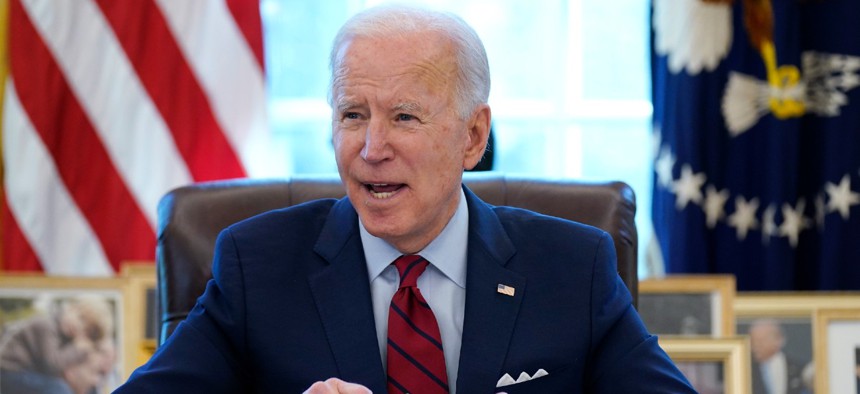Report: Requirement for Federal Contractors to Pay $15 Minimum Wage Will Have ‘Minor’ Impact on Government Spending

Evan Vucci / AP
Agencies still should be proactive in planning for implementation, consultancy says.
President Biden’s executive order requiring a $15 minimum wage for workers on federal contracts starting next year will have a “minor” impact on government contract spending of $1 billion to $2 billion annually, according to a new report.
“The [April 27] executive order will have a minor impact on overall contract spending,” said the analysis from Censeo Consulting Group published Wednesday. “In fiscal year 2019, the federal government spent approximately $597 billion on goods and services, supporting a contractor workforce of approximately 5 million individuals. Approximately 14% of this workforce (695,000 individuals) have job classifications whose hourly rates may be impacted by the executive order.”
Those individuals paid by the hour were working on contracts that represented only 3% of the government’s overall fiscal 2019 contract spending, or $20.6 billion. “And, as many individuals supporting these contracts currently receive wages above $15/hour, Censeo estimates that only 5% to 10% of this potential spend would ultimately be impacted by the EO,” said the report. “As such, the total impact to federal spending will likely be between $1 billion and $2 billion” annually.
Censeo noted this “generally aligns” with the cost estimate from the Economic Policy Institute. The consultancy used data from the Commerce and Labor departments, General Services Administration, System for Award Management and USAspending.gov, as well as interviews with relevant experts, for its analysis.
In terms of location, federal contract employees in Southern and Midwestern states are most likely to be impacted by the order. Also, rural areas versus urban ones will more likely be affected.
Censeo projected that the types of jobs and number of contracts likely to be impacted are: janitorial services (10, 636 contracts), landscaping services (5,400), nursing services (3,663), office administrative services (3,017), food services (1,852), dry cleaning and laundry services (1,058) and other positions (4,894). The total number of contracts that could be affected is 30,520, the firm said.
The chart below from Censeo shows which agencies predominately hold contracts likely to be affected and the costs.

“Our analysis suggests this is going to be a medium complexity contract modification that’s going to need to happen,” said Curt Cote, Censeo managing director. Censeo projects tens of thousands in contract spending will need to be reviewed for compliance with the order and modified, which will add on 450,000 total hours to contracting officers' workload and is the equivalent of over 240 full-time employees.
“Agencies need to figure out” how to handle “this crush of work coming,” as in whether or not they will bring in additional employees to help, Cote said. Censeo recommended agencies be proactive in planning for the implementation and listed specific steps for doing so in the report.
When Biden first announced in January this executive order was coming, Jaime Contreras, vice president of 32BJ SEIU, the country’s largest property service workers union, which has 1,000 federally contracted janitors and security officers in the Washington, D.C., area and New York City, said the president is not just “helping to lift communities out of poverty and improve lives, but he’s also enabling working families to better support local businesses, boost our economy and alleviate overburdened state and federal programs.”
Censeo said the broader economic impact of the executive order was outside the purview of its analysis.
The executive order builds on one from President Obama in February 2014, which required federal contractors to pay their workers $10.10 per hour. Currently, the minimum wage for workers on federal contracts is $10.95 per hour and the tipped minimum wage is $7.65 per hour.
A White House official told Government Executive, “We think that increasing the minimum wage will have a major impact on the lives of the hundreds of thousands of workers impacted.”
For example, “A full-time worker currently making the minimum of $10.95 an hour could earn more than $8,000 [extra] over the course of the year. They could put that towards a down payment on a house, send a kid to child care, or just put food on the table so they only have to work one job.”
Additionally, the executive order “will have impacts beyond federal contracting, as competitors in the same labor markets as federal contractors may increase wages, too, as they seek to compete for workers,” said the official. “Employers may seek to raise wages for workers earning above $15 as they try to recruit and retain talent.”
In addition, “research shows that when the minimum wage is increased for workers, the workers who benefit spend more, a dynamic that can help boost local economies,” said the official. “Raising the wage for workers can narrow racial and gender inequities by income. So, we think the president’s executive order is a big deal.”
Earlier this month, Government Executive reported how the upcoming rulemaking process will show the full scale and scope of the executive order.






